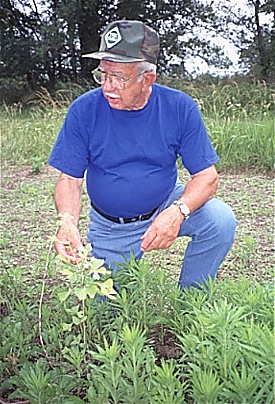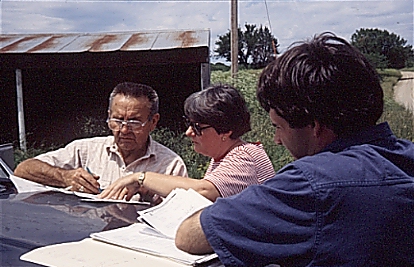Lewis Griffith lives two miles from where he grew up in Knox County. He hasn't always been there. He returned in 1979 after a career with the U.S. Agency for International Development, having lived in Ghana, West Africa, Kenya, East Africa, Guatemala and Brazil and having traveled extensively in the rest of Central and South America. In 1983 he started planting trees on his farm. He says part of what influenced him was the severe deforestation in the countries where he had served. The influence must have been quite strong, because in 1997 he was recognized as Tree Farmer of the Year for his efforts.
"You don't think you'll ever come home," he says. But he has settled in and, in addition to 74 acres of timber on his farm, he has several agroforestry sites using alley cropping. On one site he is growing red pine, which has a long needle, to demonstrate the potential the needles have as pine straw, an excellent mulching material. Between the rows he grows hay, a brome and red clover mix. On another site he has a medicinal alley cropping system with purple coneflower plants between rows of ginkgo trees. The biggest challenge is controlling the weeds in the purple coneflower plantings. As Griffith says, he is still learning about planting purple coneflowers and about harvesting ginkgos. Another agroforestry site on his farm is a 30-foot tree buffer of hazelnut trees, witch hazel shrubs and hawthorne trees that he planted for wildlife. He planted witch hazel for its medicinal value. He plans to harvest the hazelnuts if the wildlife do not get to them first!

Agroforestry:
An investment in erosion control
Frank Thomas is looking to agroforestry to protect some of his long-term investments. Thomas, who lives in Liberty, Mo., has invested in several tracts of farmland in north Missouri. His goal is to preserve the most highly erodible landscape by seeding it to grass and leasing it for pasture. An added element of erosion protection comes from trees planted on the contour at 60-foot intervals and 9 feet apart within the rows.

This agroforestry system is one of several demonstrations funded by the Missouri Department of Conservation through the Missouri Agroforestry Program. The Missouri legislature established this program a few years ago to encourage agroforestry practices. Limited funding from MDC has made about a dozen of these demonstrations possible.
The purpose is to show that a landowner can plant trees on cropland or pastures and continue to have an income while the trees are growing. The program allows the landowner to receive the average Conservation Reserve Program payment rate for that county minus the gross income from any farming practices such as cropping , haying or grazing the alleys between the trees.
Thomas has 110 acres in the agroforestry program using hay as his alley crop. The forage consists of timothy, brome and orchardgrass. A nurse crop of wheat was used to get the stand off to a good start. A few days after the grass planting was made, Thomas hired a professional tree planting service from Burlington, Ia. to plant the trees. Under his 3-year contract, the tree service comes back each year to spray herbicide to insure good growth without weed - especially grass - competition.
The tree species were mixed with black walnut, pecan, swamp white oak, red oak and white oak. Pines were planted in some areas. Liveability for the pines was poor, but the deciduous species had about 90 percent survival.
The 60-foot alleys were chosen so hay equipment could easily pass through without damaging trees.
"I like to see about 80 trees per acre," says Lonnie Messbarger, MDC forester who helped Thomas design his system. With the 9-foot spacing between trees within the row, Thomas has a few more than 80.

Although the system was established in 1997, two hay crops had been harvested by summer of 1998. The hay crop is estimated to be worth $10 per acre on a cash rent basis to a neighbor. Using the program formula of taking the local CRP rate ($60 to $65 per acre) and subtracting cash crop value, Thomas realizes $50 to $55 an acre cash flow from the program payments annually.
"Sure, there's a money consideration there," says Thomas, "but I wanted to stop erosion."
"I don't expect top dollar, but have to have something (for the investment). This is far better than the CRP program. We are using the hay crop and eventually will have a tree crop."
A bonus crop has emerged from the improved land. The quail and pheasant aren't harvested by Thomas, but are appreciated by local hunters, says Thomas.